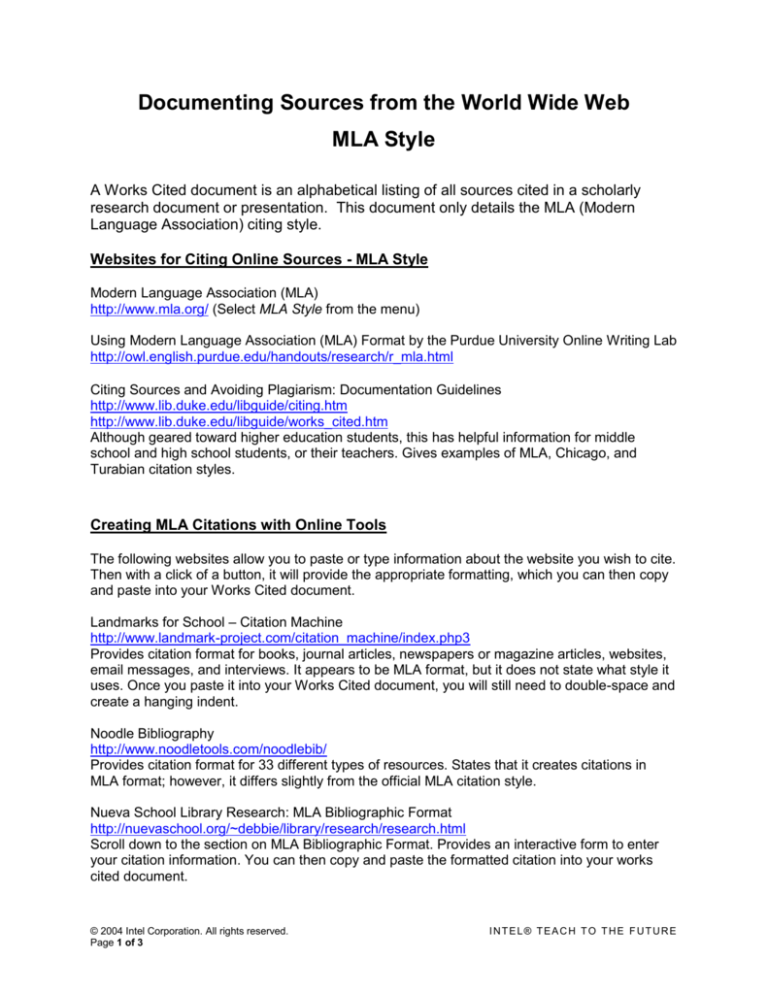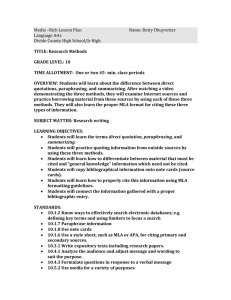
Documenting Sources from the World Wide Web
MLA Style
A Works Cited document is an alphabetical listing of all sources cited in a scholarly
research document or presentation. This document only details the MLA (Modern
Language Association) citing style.
Websites for Citing Online Sources - MLA Style
Modern Language Association (MLA)
http://www.mla.org/ (Select MLA Style from the menu)
Using Modern Language Association (MLA) Format by the Purdue University Online Writing Lab
http://owl.english.purdue.edu/handouts/research/r_mla.html
Citing Sources and Avoiding Plagiarism: Documentation Guidelines
http://www.lib.duke.edu/libguide/citing.htm
http://www.lib.duke.edu/libguide/works_cited.htm
Although geared toward higher education students, this has helpful information for middle
school and high school students, or their teachers. Gives examples of MLA, Chicago, and
Turabian citation styles.
Creating MLA Citations with Online Tools
The following websites allow you to paste or type information about the website you wish to cite.
Then with a click of a button, it will provide the appropriate formatting, which you can then copy
and paste into your Works Cited document.
Landmarks for School – Citation Machine
http://www.landmark-project.com/citation_machine/index.php3
Provides citation format for books, journal articles, newspapers or magazine articles, websites,
email messages, and interviews. It appears to be MLA format, but it does not state what style it
uses. Once you paste it into your Works Cited document, you will still need to double-space and
create a hanging indent.
Noodle Bibliography
http://www.noodletools.com/noodlebib/
Provides citation format for 33 different types of resources. States that it creates citations in
MLA format; however, it differs slightly from the official MLA citation style.
Nueva School Library Research: MLA Bibliographic Format
http://nuevaschool.org/~debbie/library/research/research.html
Scroll down to the section on MLA Bibliographic Format. Provides an interactive form to enter
your citation information. You can then copy and paste the formatted citation into your works
cited document.
© 2004 Intel Corporation. All rights reserved.
Page 1 of 3
INTEL® TEACH TO THE FUTURE
General Rules for Citing Electronic Sources – MLA Style
When listing an online source originally printed in a book or journal or other printed
format, use the general guidelines you would use to cite the printed form. Then follow it
with information that tells where you found the source on the Internet.
Indent 1cm after the first line of each entry (hanging indent) and double-space.
Alphabetise entries by author; if no author is given, begin with title.
When citing electronic sources, you should include both the date of original publication
(if available) and the date that the material was accessed.
Add the electronic address (URL) used to access the document (e.g.,
<http://www.nhmccd.edu/lrc/kc>.) NOTE: The address should be given inside angle
brackets: <http://www.wisc.edu/writing/Handbook>. Put a fullstop at the end of the
bracket.
For more help, refer to the new MLA Handbook for Writers of Research Papers, 4th ed
(rules 4.9.3 and 4.10.7)
Citing Web Pages – MLA Style (Sites or pages originally created for publication on the
Internet)
Include the following items if available in this order (the most often used elements are in bold):
1. Name of the author (if given; includes names of people, companies, organisations,
agencies).
2. Title of the poem, short story, article, or similar short work within a scholarly project,
database, or periodical (in quotation marks).
3. Title of the original print book (underlined).
4. Name of the editor, compiler, or translator of the text (if relevant and not cited earlier),
preceded by the appropriate abbreviation, such as Ed.
5. Publication information for any print version of the source.
6. Title of the scholarly project, database, periodical, or professional or personal website
(underlined) or a description if no title, such as Home page (not underlined).
7. Version number of the source or other identifying number (volume, issue, etc.).
8. Date of creation, publication, or copyright, and date last updated.
9. Name of subscription service, discussion list, or forum.
10. The number range or total number of pages, paragraphs, or other sections, if they are
numbered.
11. Name of person, agency, institution, or organisation sponsoring or associated with
this site.
© 2004 Intel Corporation. All rights reserved.
Page 2 of 3
INTEL® TEACH TO THE FUTURE
12. Date you accessed this website or page.
13. Internet address in angle brackets; or, for a subscription service, the URL of the
service’s main page (if known) or the keyword assigned by the service.
Basic Web Page Citing:
Last name, First name of Author and any other Authors. “Title of Work.” Name of Site. Date of
Posting/Revision. Organisation. Date of Access <URL>.
EMail
1. Writer
2. Subject or title of document if given (enclosed in quotation marks.)
3. A description of the document that includes the recipient's name (e.g. "EMail to Peggy
Whitley")
4. Date of the document
Email Citing Example:
Author. "Title of the message (if any)." Email to recipient’s name. Date of the message.
© 2004 Intel Corporation. All rights reserved.
Page 3 of 3
INTEL® TEACH TO THE FUTURE








